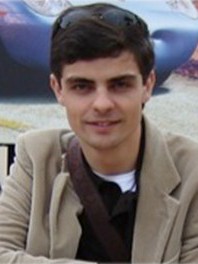resumo
The postsynthetic modification of metal-organic frameworks is a promising new route for engineering optical centres and tuning the light emission properties of materials. Here, the postsynthetic modification of isoreticular metal-organic framework-3 (IRMOF-3) with ethyl oxalyl monochloride and ethyl acetoacetate followed by the chelation of trivalent lanthanide ions afforded efficient near-infrared (Nd3+) and visible (Eu3+ and Tb3+) light emitters. IRMOF-3 was used as an example owing to its highly porous crystalline structure and the presence of non-coordinating amino groups on the benzenedicarboxylate (bdc) linker, which are amenable to modification. The conversion of the amino groups was 100 and 65% for ethyl oxalyl monochloride and ethyl acetoacetate, respectively. The materials were characterised by elemental analysis, powder X-ray diffraction, optical and scanning electron microscopy, Fourier transform infrared spectroscopy, and solution (H-1) and (C-13) solid-state nuclear magnetic resonance spectroscopy. The solid-state luminescence properties of Ln-modified IRMOF-3 were investigated at room temperature. The presence of the bdc aromatic ring, beta-diketonates and oxamate enhanced the Ln(3+) sensitization through ligand-to-metal energy transfer. The magnetic behaviour of all compounds was further analysed. The spin-orbit coupling and zero-field splitting parameters were evaluated by fitting the experimental magnetic susceptibility to the analytical expressions for the free Ln(3+) ions.
palavras-chave
METAL-ORGANIC FRAMEWORKS; LANTHANIDE COORDINATION POLYMERS; 2ND-ORDER ZEEMAN TERMS; RARE-EARTH; MAGNETIC-PROPERTIES; PARAMAGNETIC-SUSCEPTIBILITY; LUMINESCENCE PROPERTIES; HYDROTHERMAL SYNTHESIS; INORGANIC HYBRIDS; COMPLEXES
categoria
Chemistry
autores
Abdelhameed, RM; Carlos, LD; Rabu, P; Santos, SM; Silva, AMS; Rocha, J
nossos autores
Grupos
G1 - Materiais Porosos e Nanossistemas
G2 - Materiais Fotónicos, Eletrónicos e Magnéticos
G6 - Materiais Virtuais e Inteligência Artificial
Projectos
agradecimentos
The authors would like to thank the Portuguese Fundacao para a Ciencia e a Tecnologia (FCT), the European Union (EU), the Quadro de Referencia Estrategica Nacional (QREN), the Fundo Europeu de Desenvolvimento Regional (FEDER) - through the Programa Operacional Factores de Competitividade (COMPETE) - projects FCOMP-01-0124-FEDER-037296 ref. PEst-C/QUIM/UI0062/2013 and FCOMP-01-0124-FEDER-037271 ref. PEst-C/CTM/LA0011/2013, and the Portuguese National NMR Network. The authors further acknowledge EU COST Action (grant MP1202). The help of R. A. S. Ferreira and V. T. Freitas in the photoluminescence measurements is much appreciated. The authors would like to thank the Labex NIE, Strasbourg, France for granting aid and A. Derory for technical support in magnetic measurement.





